 By Jim Stevenson
By Jim Stevenson
Welcome many new people!
First, some goodies attached, includes a fall bird migration article, a shorter article for the GCDN on how Galveston has morphed ornithologically (both written by me), some totally goober jokes about how hot it’s been this summer and many of the birds we saw on last Sunday morning’s 3.5-hour field trip on the West End of Galveston ($25). We’re repeating it this Sunday, and if the front moves through, it could be spectacular (I’m not kidding!).
Here’s a nice link on how hummingbirds feed.
It appears the four-day photography session on the UTC will not fill, so there will be room for people to attend on a daily basis for $100/day. Let me know if you want to attend. While I cannot predict what we will do on which day, places we will shoot will include Quintana, Follet’s Island Beach, San Luis Pass, my property, Laffite’s Cove, Bolivar, High Island, Sabine Woods and ESPECIALLY the Smith Point Hawkshoot Tower. Winking smile Lemme know if you wish to reserve a day. You will be commuting each day, of course, we’ll have low numbers, and obviously I know how to get good pictures of our birds.
THIS IS THE LAST CALL FOR ANYONE INTERESTED IN THE FLORIDA TRIP IN EARLY DECEMBER.
If anyone would have an hour or so, three times a year, to do the Gull delivery for Galveston, please let me know.
OK, here are warblers from the first half of the fall migration on today’s gallery, so please enjoy!
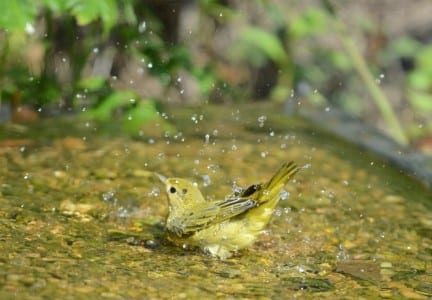
By far, the most abundant warbler in the first half the fall migration is the Yellow. The only marking the species ever has is the garnet streaking on the chest of the spring male, so in fall they are your basic yellow. However, here is something about garnet and gold this FSU grad likes… Yellows have a bright chip a little like a redstart and they absolutely love water! This one is bathing in my drip.
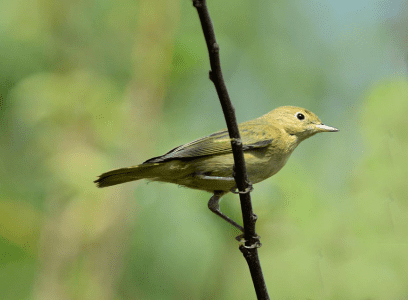
Immature yellows do not especially live up to their name until they return in spring with a winter under their belt. In this plumage, one could mistake it for an orange-crown or perhaps a Tennessee, depending on how well they’ve seen it. But the total lack of markings should be the dead giveaway.
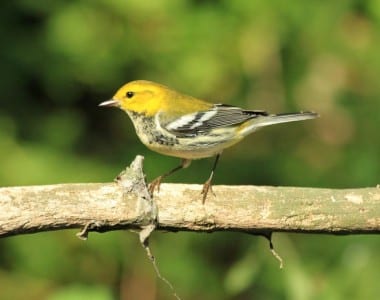
Black-throated Green Warblers, like this young male, may be found from August through early November. Many of the males are in changing plumage but completely plumaged birds are also seen. Every BTGW seen must be quickly studied to make sure it’s neither a Townsend’s (from the Far West) nor a Golden-cheeked, which despite nesting as close as the Austin area, has not been seen in several decades on the UTC.
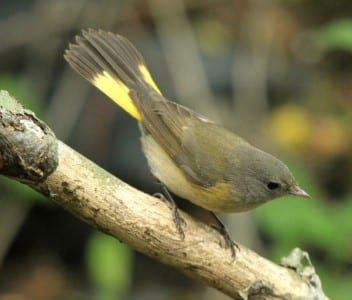
These redstarts have more windows than a Feather Fest bus. These are used, of course, to scare up bugs hiding in leaves and bark. The wing-patches are harder to see until the bird flicks its wings. These females have yellow where the males have red. And of course, that color gives the bugs a “start.”There are several other species in the Tropics.
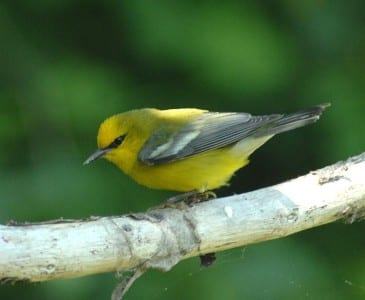
I couldn’t get this stupid bird to come out of the shade! Grrrr! But this is the Blue-winged Warbler, one of our “yellow” warblers that requires us look carefully. The black eye-line is instructive and the dark wings with white wingbars means it’s a full-blooded individual. If the wingbars are yellow, it’s got Golden-winged Warbler in its genes. Everything but blue, huh? 😉 This could be a very difficult bird to identify, but it seemed to be a Mourning Warbler. At least at first. Obviously, the white around the eye – not complete ring – favored the rare MacGillivray’s Warbler from the West, but the tail seemed short, the throat seemed too light and the line from the eye to the bill wasn’t white enough. Yes, these birds are a bear. My conclusion? A hybrid between those two species. It’s not unprecedented, and appears to be correct.
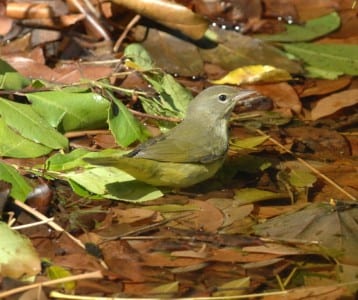
This could be a very difficult bird to identify, but it seemed to be a Mourning Warbler. At least at first. Obviously, the white around the eye – not complete ring – favored the rare MacGillivray’s Warbler from the West, but the tail seemed short, the throat seemed too light and the line from the eye to the bill wasn’t white enough. Yes, these birds are a bear. My conclusion? A hybrid between those two species. It’s not unprecedented, and appears to be correct.
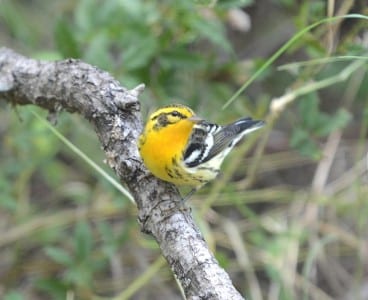
A beautiful warbler is the Blackburnian, and rather interesting in that they may be seen from August through early November. This is the fall male, beautiful in its own right, but hardly a match for the gaudy spring male. Then, we see them in varying shades of plumage development. Females are always less orange and lack the black ear.
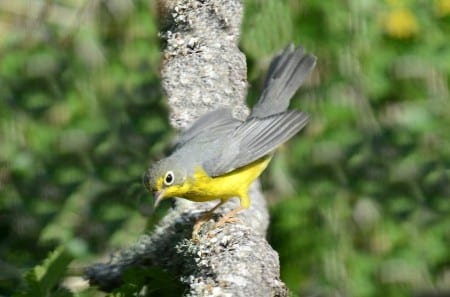
Canada Warblers are fairly common in late August and early September, as are the very secretive Mourning. This species is known for their white eyering, solid gray top and yellow underside, with varying degrees of streaks. They are quite active insectivores, so this gal has her wings out and tail up. Named for our neighbors to the North, they are fairly easily found toward the tops of the southern Appalachians.
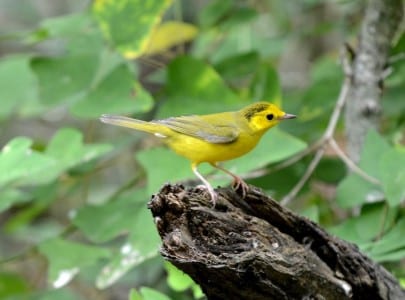
Hooded Warblers are denizens of thick woods – often swamps – and moist forests. They have a loud, liquid chip and are constantly hopping around in active feed. This female shows how her gender lacks the black helmet of the male, which gives the species its name. They are rarely more than five feet above the ground.
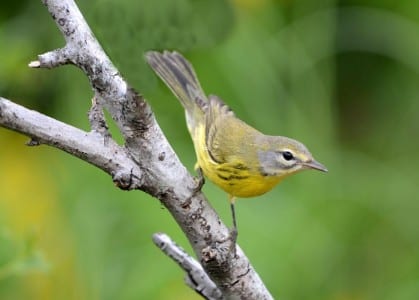
Prairie Warblers are very eastern birds, with the vast majority of records in Texas being August and early September (“five !” here this fall!), presumably due to the increase of east winds. This male shows how they are one of the species that dresses down for autumn, although they aren’t bad looking, either! The few males we get in early spring are absolute knockouts!
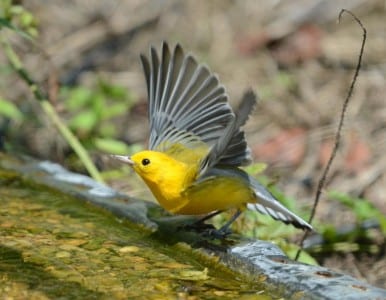
Prothonotary Warblers are certainly no stranger to water; this male seems to be enjoying himself. Named for the office in the Catholic Church that wears the golden robe, they are a sudden sunbeam in a dark swamp on their breeding grounds. Note the relative size of the bill: These birds pull all kinds of arthropods, etc., out of crevices for their food.
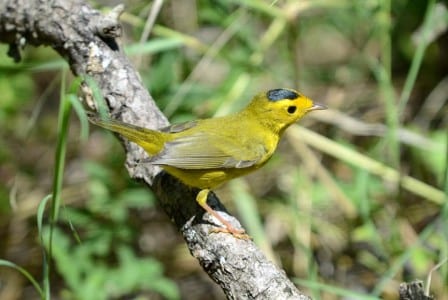
This is about the time the Wilson’s, and then Nashville Warblers, come in en mass, and the former species here is showing off his French cap. Their cocked tail is also diagnostic, but they have little else except your basic yellow. This is a mid-range bird in the canopy but they love water, and that give us a better look at their cap. Females lack the cap but have enough of an outline that you can tell them from Yellows (which are winding down for the fall).
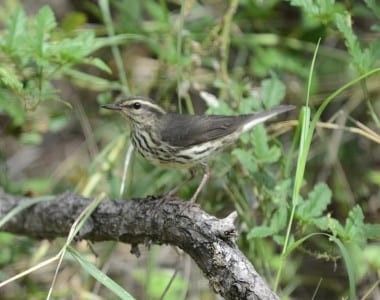
Northern Waterthrushes are warblers that love shores of quiet bodies of freshwater, often in swamps or bogs. This individual lacks the wide, white eyestripe and pink legs of the Louisiana Waterthrush, as well as the beige flanks. They are not the extremely early migrant the Louisiana is, as we have November migration records.
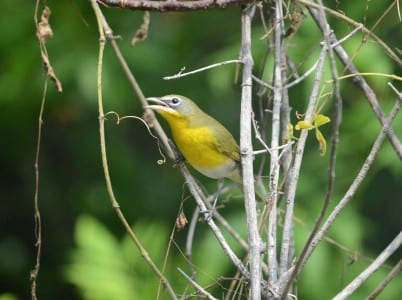
Yellow-breasted Chats are relatively early fall migrants, shy of people and impressive with their bright yellow throat and chest. Their bill allows them to not only snag fruit; they have been known to take large spiders and even small vertebrates. They are well-known for their amazing array of imitations, rivaling mockingbirds in species count. I’ll have to say, though, that nothing – and I mean nothing – compares to the vast verbal array of sounds emanating from the vocal chords of the lyrebird of Australia. All that talent while hanging precariously on an upside down continent between two oceans! 😉 Few birds appear “sharper” than the Yellow-throated Warbler, a southern breeder and very early migrant. Don’t confuse this bird’s name with the Common Yellowthroat, or the Yellow-throated Vireo. I will say this bird looks quite a bit like the Black-throated Gray Warbler from the back, when the yellow is hidden. These guys work the bark for insects, though not as woodpecker-like as the Black-and-white Warbler.
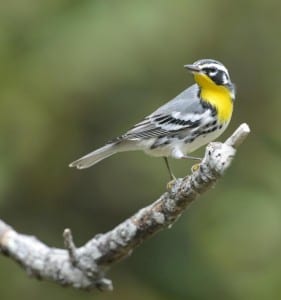
Few birds appear “sharper” than the Yellow-throated Warbler, a southern breeder and very early migrant. Don’t confuse this bird’s name with the Common Yellowthroat, or the Yellow-throated Vireo. I will say this bird looks quite a bit like the Black-throated Gray Warbler from the back, when the yellow is hidden. These guys work the bark for insects, though not as woodpecker-like as the Black-and-white Warbler.

 Posted in
Posted in 
























Hey there would you mind letting me know which webhost you’re utilizing?
I’ve loaded your blog in 3 different web browsers and I must
say this blog loads a lot quicker then most. Can you suggest a good hosting provider at a fair price?
Thanks, I appreciate it!